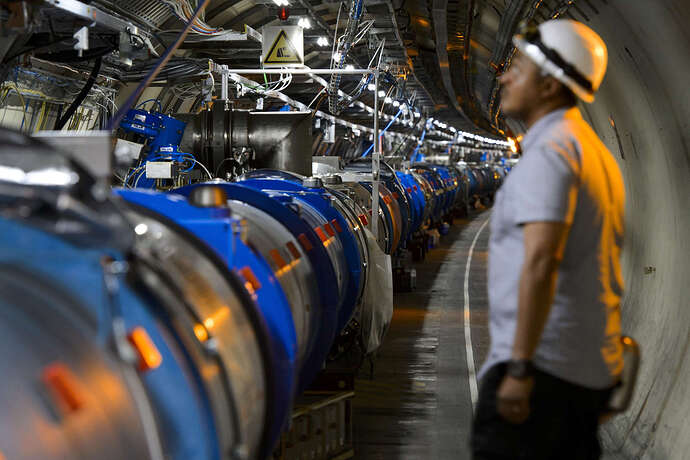Neutrino Signals Detected at Large Hadron Collider for First Time Ever
Ed Browne 4 hrs ago
[image]
© Fabrice Coffrini/AFP / Getty A scientist looks at a section of the Large Hadron Collider at the European Organisation for Nuclear Research (CERN) in Switzerland, July 2013. Scientists have detected signs of neutrinos in the collider.Physicists at the Large Hadron Collider (LHC) at the European Organization for Nuclear Research, or CERN, have reported the detection of neutrino signals in a world first for the particle smashing machine.
Neutrinos are fundamental particles of the universe, meaning that they are not made up of any smaller components as far as we know.
Scientists have been hunting neutrinos for years, and special detectors have confirmed their presence before.
It’s thought that if physicists can learn more about them, they can answer some of the most pressing questions in physics—such as why we live in a universe of matter and not antimatter.
But neutrinos are notoriously elusive. This is in part because they are incredibly small and light, with a mass hundreds of thousands of times less than that of an electron—which itself is hardly gigantic.
This means that they pass through almost everything they encounter. It’s thought that trillions of them are passing through our bodies and out the other side every single second.
We know that some neutrinos are created in the heart of the sun, and others should also be created when the LHC smashes particles together. But to date, scientists have never detected a neutrino that has been produced by a particle collider.
To get around this, researchers have designed a special particle detector called FASER that is meant to be attached to the LHC and detect these neutrinos.
The final product is due to start taking its first measurements some time next year, but in 2018 the team installed a prototype to take some early measurements.
Using this prototype, the researchers discovered a total of six “neutrino interaction candidates” inside the LHC, proving the detector’s effectiveness.
Jonathan Feng, co-leader of the FASER Collaboration and a professor of physics at the University of California, Irvine (UCI), said in a university press release: "Prior to this project, no sign of neutrinos has ever been seen at a particle collider.
“This significant breakthrough is a step toward developing a deeper understanding of these elusive particles and the role they play in the universe.”
The researchers announced their discovery in a study published in the journal Physical Review D on Wednesday.
The detector uses lead and tungsten plates to detect the neutrinos. During an LHC experiment, particle collisions produce neutrinos that then pass interact with these dense metal plates and leave behind marks, according to UCI. By studying these tell-tale signs, physicists can learn a lot about the neutrinos including their energies and their type.
The news follows another recent neutrino announcement from in October following a painstaking search for the most elusive neutrino of all—what’s known as a sterile neutrino—that did not result in one being found.

